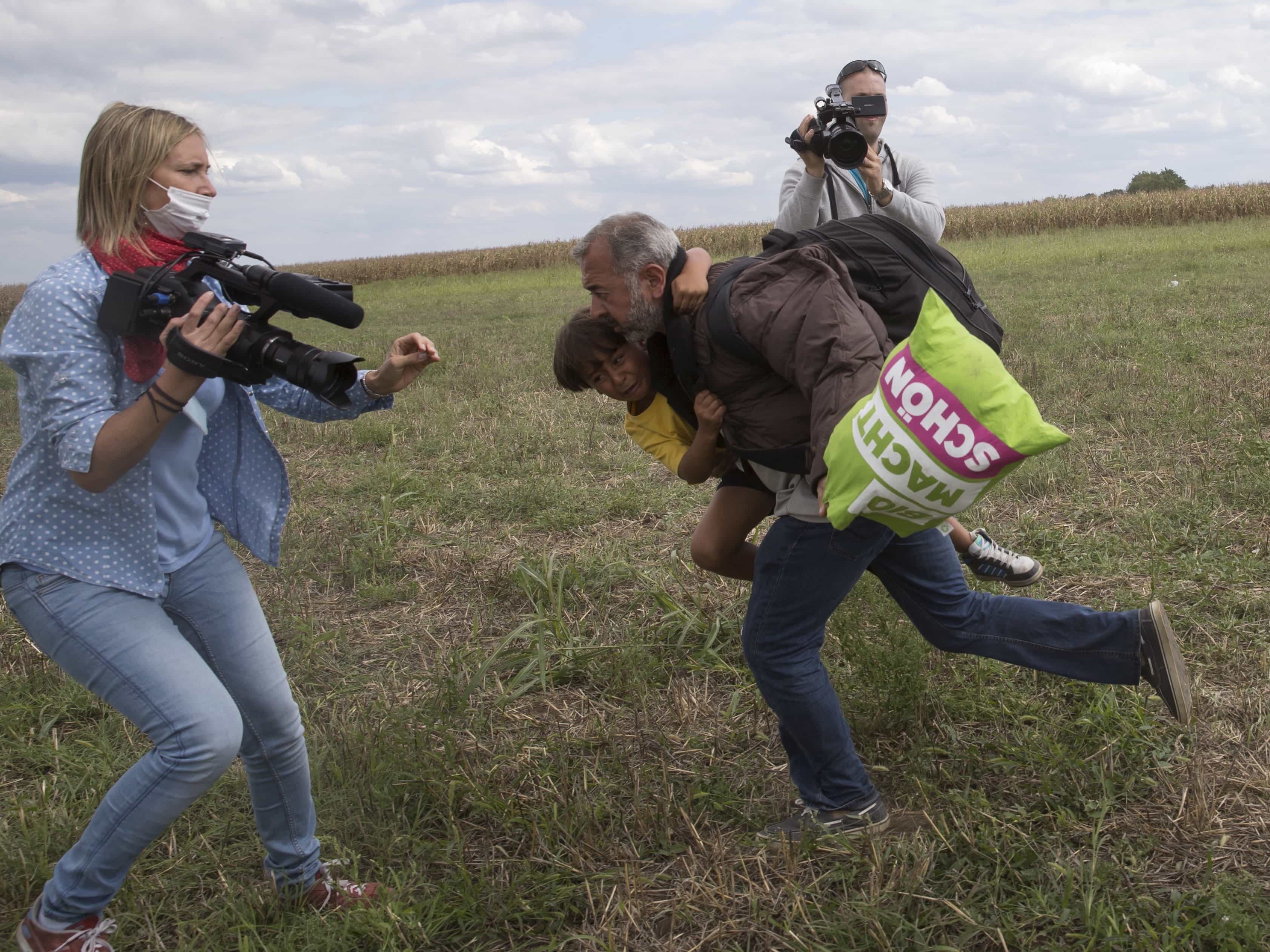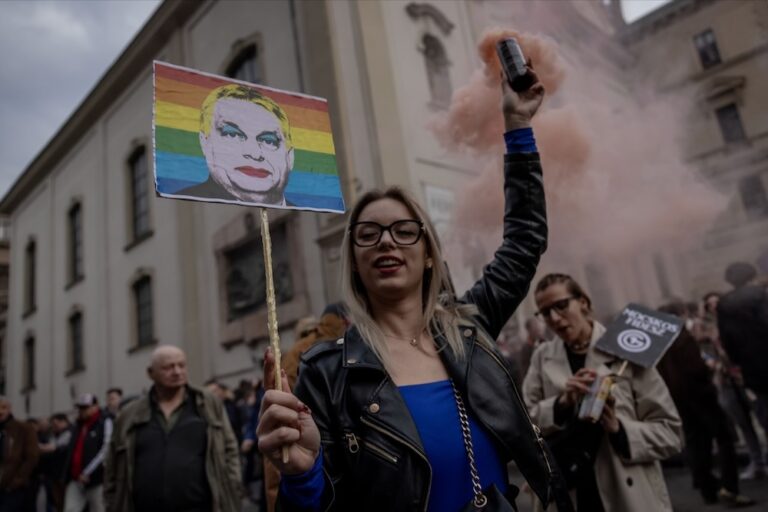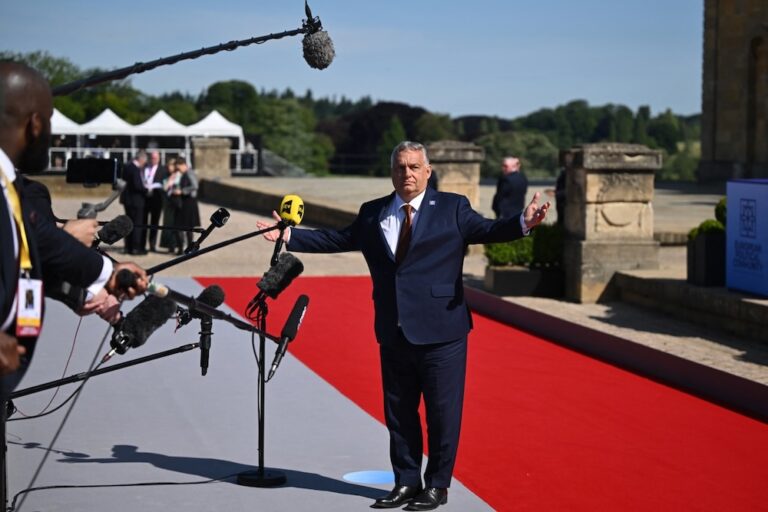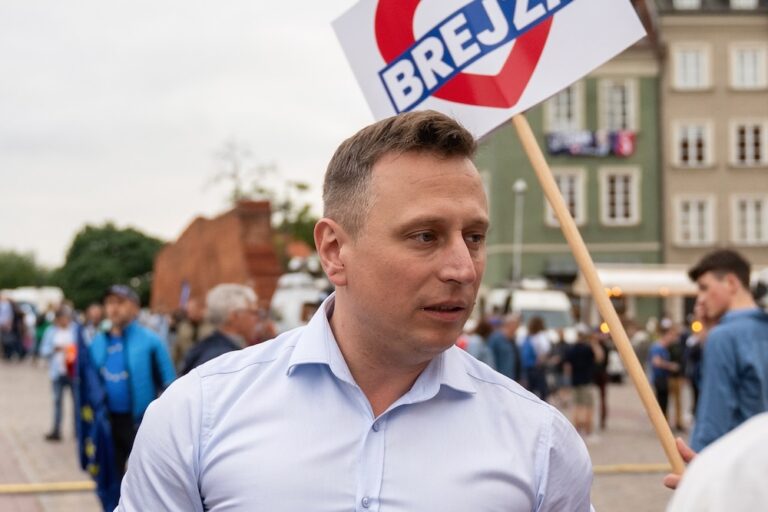IFEX speaks with the Hungarian Civil Liberties Union's Dalma Dojcsák about press freedom in Hungary, the social implications of Prime Minister Viktor Orban's anti-immigrant rhetoric, and media coverage of the refugee crisis.
It’s a scene that’s difficult to un-see.
A group of refugees flees from Hungarian police officers in a field. They’re screaming. Their fear is tangible. All of a sudden, a camera operator – who is filming people close-up as they run – kicks a man holding his child.
The father and son tumble to the ground; the man yells in frustration.
The video of the incident, captured by German journalist Stephan Richter went viral over social media channels in September, with people all over the world expressing outrage over the attack.
The camera operator who tripped the refugees was Petra László, of N1TV – an “ultranationalist” online television channel linked to Hungary’s far-right Jobbik party. She was fired shortly after the incident. László would later tell journalists that she was afraid when she saw the group of people running towards her, and had acted on impulse. “I’m not a heartless, racist, children-kicking camerawoman,” László subsequently wrote in a letter to Hungarian newspaper Magyar Nemzet.
It would be simplistic to assume that László’s actions are representative of all the journalists or the entire media landscape in Hungary.
But it would also be naive to dismiss such a reaction as a one-off. Indeed, the incident raises some very important questions about the context in which the attack arose in.
After watching the video myself, I was left wondering how the government of Prime Minister Viktor Orban – who is infamous for his anti-immigrant rhetoric – influences Hungarian society’s opinions of the current refugee crisis.
But I was equally interested in some of the more subtle and structural factors that contribute to a media landscape where these kinds of hateful instances are at risk of occurring.
In order to gain perspective on all these issues, I spoke with Dalma Dojcsák, a freedom of speech expert with the IFEX member organization Hungarian Civil Liberties Union.
Dojcsák is a Budapest-based Hungarian lawyer. Her work includes strategic litigation, legal analysis and communication in freedom of expression and freedom of media cases. She is a PhD student of the Doctoral School of Law at ELTE, Budapest. Her research focuses on the role of the media in a democratic society.
The following Q & A is a combination of audio and written responses.
Caro Rolando: Can you give us a sense of the press freedom landscape in Hungary at the moment?
Dalma Dojcsák: Press freedom in Hungary, I would say, [has been] in a decline in the past few years. If you look at the Freedom of Speech Index, for example, of Freedom House, you can see how the press in Hungary drifted from the “Free” to “Partly Free” category. I would say that it’s only the Internet that is still mostly free of governmental pressure.
CR: How is it influenced by legislation, if at all?
DD: There were new media laws introduced in 2010, when the government of Mr. Orban was elected. And these new media laws were harshly criticized, nationally and internationally, and they were said to be restricting freedom of the press. Because of these heavy criticisms, some amendments were made to the media laws. But I would say that they were not enough. Those provisions [that] stayed in the text would result in self-censorship among journalists.
CR: What kinds of provisions would you say specifically encourage self-censorship among journalists?
DD: The media authority has broad powers over every kind of media in Hungary: electronic media, online and offline press. It also has the power to impose heavy fines on media outlets. Although these kind of fines are rarely imposed, the mere possibility of being fined can result in a chilling effect for the media.
CR: How do media outlets in Hungary stay afloat financially?
DD: If a media organization wants to stay alive basically, they have to receive some sort of advertising funding from the government, one way or another. That it be the government itself, or the state, or the state-owned big companies, or those companies that are owned by businessmen who are really close to the government. And I would say quite few media outlets can say that they are financially independent from the government.
CR: Tell us a bit about the public service media in Hungary.
DD: Partly because of the 2010 media legislation, the public service media is highly dependent on the government, both financially and in terms of personal engagement. In the last few years we can see how the public service media became basically a mouthpiece for the government, and how [it] even published fake footage [and] disseminated information that was not true, and it was obvious that it was not true. I think this is one reason why quite a few people refuse to watch or listen to the public service media. Public service television reaches about 5-10% of the whole population, despite the fact that a huge amount of money is spent on it.
CR: Can you share any examples of media outlets disseminating false information?
DD: In 2012, an anti-government demonstration was held before the Opera House in Budapest. Thousands of people attended – I was there, too. [Dojcsák sent us a still from the video footage broadcasted that night by the public service media: http://m.cdn.blog.hu/re/republikon/image/TV.jpg] The reporter intentionally looked for an empty street with only a few people to report on the demonstration. He became an internet meme after this. Concerning the recent refugee crisis, the public service media broadcasted anti-refugee propaganda in accordance with the agenda of the Orban government. After the border fence was built, public television reported that children were thrown over the fence by their parents. This information was never proved by any other media outlet or source. Also, the public television channel ‘found’ mobile phones near the border that were allegedly left behind by refugees and contained pictures and videos from the war zone. The conclusion presented in the program was that the owners of the mobile phones are terrorists coming to Europe.
CR: How do private media outlets factor into this media landscape?
DD: There are the commercial media channels, both television and radio. But they are either non-political, in a way that they don’t really disseminate political news, or they are friendly to the government. And there are only small television and radio channels which are somehow critical to the government.
CR: How does the small market for private media outlets affect the quality of journalism in Hungary?
DD: High-quality journalism, fact-based journalism, political journalism is quite rare in Hungary. And those stories that are investigative in nature are not so often published. There are some small websites that really focus on investigative journalism, but they are mostly non-profit, and the major stories are quite rare on those sites.
CR: Can you give us an example of what happens to a media outlet when it attempts to express itself independently of the Hungarian government?
DD: There is RTL Klub – the biggest Hungarian commercial television channel – which was not really interested in political news, they are mostly into entertaining. The government wanted them to change their news programs to be in favour of the government. They refused to do so. Therefore, in 2014, the government introduced The Advertisement Tax, and that consisted of different terms for different income levels. It was only RTL Klub who fell into the highest income level of this tax. And that meant that RTL Klub would pay 50% of their income as a tax.
It was like blackmailing the channel to be government friendly. And they stood up and they started to air – after not being so political – really critical news stories about the government.
CR: Aside from openly criticising the government, how else did RTL Klub respond to the Advertisement Tax?
DD: The channel turned to the European Commission and they argued that this tax was against competition law of the European Union. And the competition law legislation is quite important in the European framework; it was quite obvious that this tax in Hungary violated competition law and it would favour the competitors of RTL Klub on the market. So, after one year, the government withdrew the tax and the taxation. So, now we have this, and RTL Klub is slowly going back to being non-political.
CR: In terms of why that tax was imposed in the first place – if they weren’t that political, what do you think the government was concerned about?
DD: Because you have to be the friends of the government to be left alone. It’s not enough if you are only neutral. And it’s quite well communicated by the Hungarian government that there’s us, and there’s everyone else. And you have to be one of us to be treated well, and everyone else is his enemy. And that’s how the government, and the prime minister talks about, for example, gay people, refugees, migrants. And there is this war rhetoric all the time that there are them who want to invade us, and who want our country, they want our money, they want everything we have. There’s this constant fear that is generated in this society, and this constant war state, that we are in war with everyone.
CR: How does the government’s “us and them” mentality affect the way the Hungarian media covers the current refugee crisis?
DD: Many people are fearful, and superstitious. And we see the same in the media. Some media outlets are also in this fearful state.
For example, as I said before, the camerawoman who attacked refugees when she was reporting on them. And later on, she said that she was really afraid of them. And that’s why she kicked and hit children. If you are a person who doesn’t really know the world, and doesn’t really travel a lot, as many Hungarians don’t, it’s quite easy to believe that people who are different from you, they, they pose a threat on you. But I think it’s our government who is mainly responsible for this, that people are in this state.
CR: What kinds of things does the government say to make people fearful of immigrants, or refugees?
DD: We had this campaign that was run by the government for a lot money in Billboards and in media, as well. We had these huge billboards all over the country, saying, in Hungarian of course, “if you come to Hungary, you cannot take our jobs.” “If you come to Hungary you have to respect our laws. “If you come to Hungary, you have to respect our values”, and stuff like that. It was obvious that it was not for the refugees, they don’t speak Hungarian. So, it was for the people to make them believe that these people are here to violate our laws, to take our jobs.
CR: Is the government using any other methods to manufacture fear of immigrants or refugees?
DD: We also had this national consultation thing, that is the favourite thing of the government when they want to implant some ideas to the population, they would make these questionnaires, which are sent out to families and to homes. And there’s this one-page questionnaire which has really prefabricated questions suggesting answers. For example, “do you think that the government should provide benefits to immigrants?” And the answers are like “no, I don’t think. I think that the government should protect, or support Hungarian families.” The other answer is “no, I don’t think that…” So there’s a “no” and a “no” option,” basically. So, you cannot answer “yes, I would like people not to, not to sleep on the streets of my country.” There’s no option like that. You can send these questions back, but basically no one sends them back, you never see the numbers on this. And after that, they would release that “90% of the people who sent the questions back, say we shouldn’t support immigrants.” And then, it’s like, you know, you can base your argument on this.
CR: Does this kind of messaging appear in government-controlled media? If so, how?
DD: The public service media produce these programs that show refugees and Facebook profiles, and maybe the same people were in the picture, but you can’t really tell. And the facebook profiles were linked to people who were terrorists in Syria, for example. But some journalists went after the story and they found out that some people who were pictured with guns on their Facebook profiles were actually Kurdish anti-terrorist fighters, and they were fighting against ISIS, but they were portrayed as members of ISIS by the public service media.
CR: What effect do you think this kind of messaging has on the population-at-large?
DD: Imagine that you are, I don’t know, a grandmother in a Hungarian village, looking at these programs and feeling like “Oh my God, terrorists are flooding my country,” while these are Kurdish people who fought against the ISIS, but left, because probably many of their friends and family members were killed. And those people who are running from the terrorists are portrayed as terrorists in the Hungarian media. So it’s really disgusting and really depressing at the same time. You know, it brings up really bad historical memories, especially in Central Europe, how the government basically incites violence and hatred against minority groups. And I think that it’s really really dangerous.
CR: What kinds of bad historical memories specifically does the current situation bring up for you?
DD: [Memories of] the Holocaust, and after, how the Roma were treated in Hungary, and how, basically, any minority was treated. For example after the Second World War, the German minority in Hungary was treated as the Jews were treated by the Germans. And they were deported. And then the Roma, who are the biggest minority group in Hungary and are discriminated against. And there were killings against the Roma some years ago in Hungary when this basically terrorist group went after Roma people and killed them in their homes, including children. It was pure terror. And now, our government is doing something quite similar. They incite against a group of people who don’t even intend to stay in our country, [refugees and immigrants] and are using our country to enter the European Union and go to Austria or to Germany.
CR: Why do you think the government employs this kind of narrative?
DD: I believe that the government does this to get political success out of this story. And to get those people who fear, to believe in a strong government that can restrict our rights. And to protect them.
CR: Are there any media outlets or government sources that encourage people to be violent?
DD: Not by the government directly, but there are some publicists. The far-right party and the far-right media, mostly publish onto the Internet, which really explicitly say that “yes, we should kick them out of our country, we should go after them.” There were these ideas of arranging the border patrol from far-right groups. I’ve seen Facebook threads that invited people to clean out the railway station, because the refugees were staying there.
CR: Do you think there’s an argument to be made for censoring these kinds of statements or publications?
DD: I believe that censorship would not be the right answer for this. I believe that counter-speech is the only way to step up against these violent ideas, and also disseminating true information is the key. I think you are just not able to censor ideas on the internet. It’s basically impossible.
CR: Have there already been efforts to censor or restrict hate speech in Hungary?
DD: There’s new legislation that enables courts to block URLs on the internet if the content that is published there is illegal or violating any provisions of the criminal court. And it was basically designed and enacted by the parliament to fight against the far-right website that is based in the US. But I think it was used only once against a page on this website that was dedicated to Holocaust denial – which is a crime in Hungary. But it’s basically useless, because it takes about a year to reach a final court decision about blocking. And then you block that page and it’s five minutes work to build up a new page with the same content.
CR: What is it like for journalists and human rights workers who are trying to document the experiences of refugees in Hungary?
DD: Sometimes the refugee camps are open, and the people who live there can leave and come back. But some of the camps are closed and they are not entitled to leave. But none of those camps are made available to journalists to enter.
We as an organization wrote to the Minister of the Interior and asked him about this situation. [We wrote] “we were informed that journalists are not allowed to enter the camps.” He informed us that, “yes, this is true” and [said] that this is to protect the rights of the people who live in these camps, the refugees. First, because, their right to privacy and family life has to be kept safe. And if journalists would enter and interview them, these rights would be violated. And, of course, we argued that the journalists have to respect these rights and they have to ask for the refugees to agree on being reported on. But the answer for that was that the refugees are not aware of the fact that the internet can disseminate this content even back to their home countries. And even if they agree to be reported on, the reports can impose danger on their family members who are staying in their home countries. According to the government’s understanding, refugees are not able to decide whether it’s dangerous for them or any family members if they make a statement in a media outlet or not. So they are not competent to decide on this question. The Hungarian government is more competent to decide on this question. And it’s better not to interview anyone, and not to publish a picture of anyone.

Dalma Dojcsák, Freedom of Speech Expert, HCLUDalma Dojcsák

Hungary’s Prime Minister Viktor Orban reacts as he arrives at a European Union leaders extraordinary summit on the migrant crisis, in Brussels, 23 September 2015REUTERS/Francois Lenoir

A migrant carrying a baby is stopped by Hungarian police officers as he tries to escape on a field nearby a collection point in the village of Roszke, Hungary, 8 September 2015REUTERS/Marko Djurica
Caro Rolando is the IFEX Section Editor for Africa, Europe and Central Asia.



